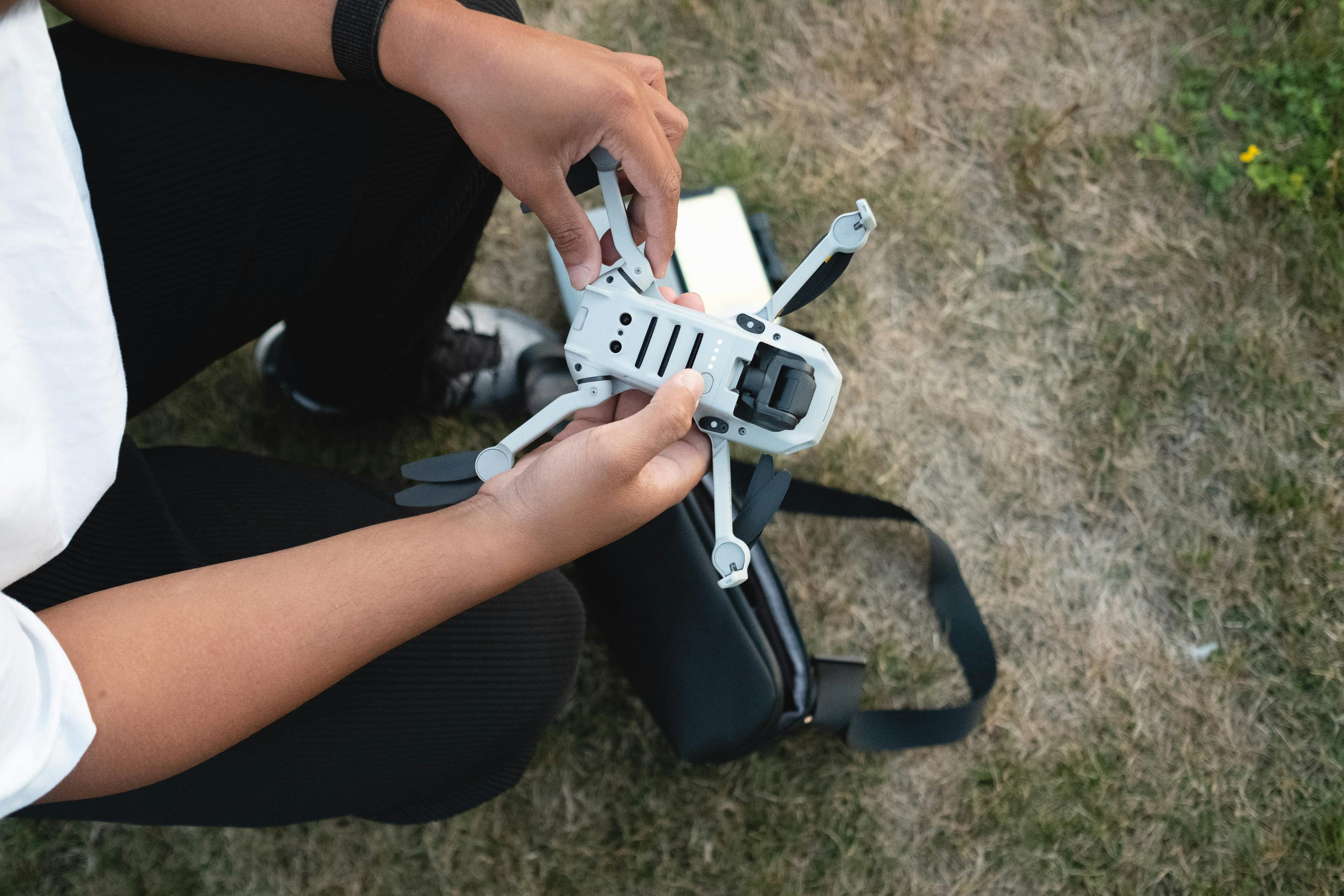Aerial perspectives: renting camera drones for stunning visual exploration
Welcome to the world of aerial photography and videography, where the sky is not the limit but your canvas! Drone cameras are revolutionizing how we capture and perceive our world, offering mesmerizing perspectives from high above. This guide will take you through the thrilling journey of capturing stunning aerial visuals that will elevate your creative storytelling.

Drone cameras: unlocking aerial creativity, expansive landscapes, and dynamic perspectives
Drone cameras are more than just flying gadgets; they are your ticket to unlocking new dimensions in visual storytelling. They allow you to soar above and showcase landscapes in their full grandeur, capture expansive vistas, and offer dynamic perspectives that ground-based cameras can't. From majestic mountain ranges to sprawling urban landscapes, drones let you capture the essence of any scene from an extraordinary vantage point.
Choosing the right drone camera for aerial exploration: flight time, camera quality and image stabilization
When it comes to aerial photography and videography, the drone camera you choose can make all the difference in capturing breathtaking visuals. Let's delve deeper into the critical factors of flight time, camera quality, and image stabilization to help you select the ideal drone for your aerial explorations.
Flight time: maximizing your time in the sky
Flight time is a pivotal aspect of drone photography. It determines how long you can stay airborne to capture your desired shots. Standard consumer drones offer a flight time ranging from 20 to 30 minutes on a single charge, while more advanced models can fly longer. When selecting a drone, consider your project's scope. Longer flight times are beneficial for extensive aerial surveys or when shooting in remote locations. Also, carrying extra batteries is always a good practice to extend your shooting session without interruptions.
Camera quality: capturing crisp, vivid aerial imagery
The quality of the drone's camera is crucial for producing sharp, high-resolution images and videos. Look for drones equipped with cameras that offer high megapixel counts and large sensors, as these capture more detail and perform better in varying light conditions. 4K video capability is now a standard feature in many drones, providing you with stunning high-definition footage. Additionally, consider the camera's field of view; a wider angle will capture more expansive landscapes, ideal for grand, sweeping shots.
Image stabilization: ensuring smooth, professional footage
Image stabilization is key to achieving smooth, cinematic aerial footage. Most high-quality drones come with a gimbal, a motorized stabilization system that keeps the camera steady despite the drone's movements. A 3-axis gimbal is ideal as it compensates for tilts, pans, and rolls, ensuring your footage is stable and free from shaky, disorienting movements. This feature is particularly important when filming in windy conditions or when executing complex maneuvers.
Additional considerations
- GPS and tracking features: Drones with GPS offer better stability, precise positioning, and advanced features like 'return to home', which automatically brings the drone back to its take-off point.
- Obstacle avoidance: For beginners or when flying in complex environments, a drone with obstacle avoidance sensors can prevent collisions.
- Ease of use: User-friendly interface and controls are important, especially for beginners. Look for drones with intuitive controls and automated flight modes.
- Portability: If you're traveling, a compact and lightweight drone is easier to carry and set up.
By considering these factors, you can choose a drone that not only meets your aerial photography needs but also enhances your creative possibilities. Remember, the right drone can transform your aerial exploration from ordinary to extraordinary, capturing stunning visuals from a bird's-eye view.
Navigating the world of drone camera rentals: tips and considerations
Renting a drone camera can be an excellent choice for both amateur and professional aerial photographers who don't own a drone or need a specific model for a particular project. Here's a guide to help you navigate the rental process, understand the conditions, and make the most out of your drone rental experience.
Understanding the rental process
Research rental options: Start by researching and comparing drone camera rental offers from online rental marketplaces or local rental shops with LetsQuip.com. Look for services with good reputations, positive customer reviews, and a range of drone models. The LetsQuip.com Score helps you find offers from reputable rental services, it’s a quality score based on previous customer’s online reviews of rental services (0-100 score).
Compare models and prices: Rental costs can vary significantly based on the drone model and rental duration. Compare options to find a balance between your budget and the features you need.
Check availability and reserve in advance: Popular models can get booked quickly, reserve your drone well in advance to ensure availability.
What to look out for
Condition of the drone: Before accepting the drone, inspect it thoroughly for any damage. Check the propellers, camera and gimbal for any signs of wear or malfunction.
Battery health: Ensure the batteries are in good condition and hold a charge. Ask about the age of the batteries and how long they are expected to last.
Familiarize yourself with the model: Each drone has its unique features and controls. If possible, request a brief tutorial or demonstration from the rental service, especially if you're using a model you're not familiar with.
Rental conditions and policies
Understand the rental agreement: Read the rental agreement carefully. Pay attention to the terms regarding damage, loss, and liability. Know what you're responsible for in the event of an accident.
Insurance: Some rental services offer or require insurance for their drones. Consider opting for insurance to protect yourself from costly damages or loss.
Deposit and identification: Be prepared to provide a valid ID and a security deposit. The deposit amount can vary, so clarify this upfront.
Specialties of renting camera drones
Specific model for specific needs: Rental services often offer a range of drones, from basic models to high-end professional drones. Choose a model that suits the specific requirements of your project, like 4K video recording or advanced image stabilization.
Accessories and extras: Check if the rental includes necessary accessories like extra batteries, memory cards, or carrying cases. Some services might offer these as add-ons.
Technical support: Inquire if the rental service provides technical support during the rental period. This can be invaluable in case you encounter any issues with the drone.
Training and certification: If you're a beginner, some rental services offer training sessions. Also, be aware of any certifications or regulations required to operate a drone in your area.
Renting a drone camera can significantly enhance your capability to capture stunning aerial visuals without the commitment of purchasing one. By paying attention to these aspects of the rental process, you can ensure a smooth and rewarding aerial photography experience.

Navigating drone regulations for aerial photography
Understanding and adhering to local drone regulations is a critical aspect of aerial photography. Drone laws vary significantly by region, and being well-informed about these regulations is essential for legal and responsible drone operation.
Understanding drone regulations
Before you embark on your aerial photography journey, it's crucial to familiarize yourself with the local drone regulations. "Full country-by-country guide to drone licenses and regulations" complements this rental guide by providing detailed insights into the legalities of drone operation in various countries. This ensures your flights are not only inspired but also in compliance with global regulations.
General regulatory advice
Research local laws: Before flying a drone, research the specific regulations in your area. Drone laws can differ greatly between countries and even within regions in a country.
Registration requirements: Many places require drones to be registered, especially if they exceed a certain weight threshold.
No-fly zones and airspace restrictions: Familiarize yourself with no-fly zones, which often include areas near airports, government buildings, and military installations.
Privacy considerations: Be mindful of privacy laws. Avoid flying over private properties and capturing images of individuals without consent.
Height and distance limits: Adhere to prescribed height and distance limits to ensure safety and compliance.
Commercial vs. recreational use: Different rules may apply depending on whether the drone is used for commercial or recreational purposes. Commercial use often requires additional certifications or licenses.
Drone regulations in the USA
In the United States, the Federal Aviation Administration (FAA) is the governing body for drone operations. Here are some key regulations:
FAA registration: Drones weighing between 0.55 pounds and 55 pounds must be registered with the FAA.
Operational categories: Distinct rules exist for recreational (hobbyist) versus commercial (Part 107) drone operations.
Flying restrictions: Drones are generally limited to a maximum altitude of 400 feet above ground level. Flying in controlled airspace near airports requires authorization through the FAA's LAANC system.
Privacy and safety: Respect individual privacy and avoid flying over groups of people, public events or stadiums.
Night operations: Night flying is permitted under specific conditions with proper drone lighting, especially for Part 107 certified operators.
Part 107 certification: Required for commercial drone operators, this certification involves passing an FAA exam on various aspects of drone operation.
Liability insurance: While not mandatory, it is advisable for commercial operators to have liability insurance.
By respecting these regulations, drone operators ensure not only their legal compliance but also contribute to the safe and respectful use of drones in shared spaces. For the most current regulations, always refer to the governing body's official resources or seek legal advice from a drone law expert.
Aerial photography techniques: composing aerial shots, capturing motion and using the third dimension
Aerial photography is an art, and mastering it requires understanding unique composition techniques. Learn how to frame your aerial shots, capture motion effectively, and use the third dimension to add depth to your visuals. Experiment with different angles, play with light and shadows and explore the balance between vast landscapes and detailed close-ups to create compelling aerial narratives.
Editing and sharing aerial visuals: tips for post-processing, color grading and aerial cinematography
The magic of aerial visuals often shines through in post-processing. Tips for enhancing your shots include color grading to set the mood and editing techniques that highlight the beauty of your aerial cinematography. Remember, the goal is to tell a story that captivates and enchants your audience. Share your aerial masterpieces on social media to showcase your unique perspective from above.
Elevate your visual storytelling: embrace the sky with a rented drone camera
As we've explored, renting a drone camera opens up a world of creative possibilities, allowing you to capture stunning visuals from a unique aerial perspective. Whether you're an amateur photographer looking to add an edge to your portfolio, a professional videographer seeking dynamic shots, or simply someone who wants to experience the world from above, renting a drone is a flexible and cost-effective solution.
The journey of aerial photography and videography is as exhilarating as it is rewarding. By choosing the right drone, understanding the rental process, and being mindful of the technicalities, you set yourself up for a successful and enjoyable experience. Remember, each flight is an opportunity to tell a story, capture a moment, or simply revel in the beauty of our world from a bird's eye view.
So why wait? Take the leap into the vast, open skies. Rent a drone camera for your next project or adventure and let your creativity soar. The world looks different from up there and it's a sight worth seeing. Ready to fly? Your aerial adventure awaits!
Also read:
Quick guide to renting a drone
7 tips for mastering camera equipment rentals
Capturing the moment: a beginner's guide to outdoor photography
Underwater photography: renting gear to capture stunning ocean memories

Matt Graham